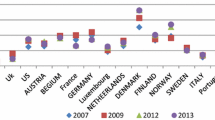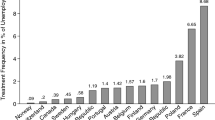Summary
The need to evaluate the performance of active labour market policies is not questioned any longer. Even though OECD countries spend significant shares of national resources on these measures, unemployment rates remain high or even increase. We focus on microeconometric evaluation which has to solve the fundamental evaluation problem and overcome the possible occurrence of selection bias. When using non-experimental data, different evaluation approaches can be thought of. The aim of this paper is to review the most relevant estimators, discuss their identifying assumptions and their (dis-)advantages. Thereby we will present estimators based on some form of exogeneity (selection on observables) as well as estimators where selection might also occur on unobservable characteristics. Since the possible occurrence of effect heterogeneity has become a major topic in evaluation research in recent years, we will also assess the ability of each estimator to deal with it. Additionally, we will also discuss some recent extensions of the static evaluation framework to allow for dynamic treatment evaluation.
Similar content being viewed by others
References
Abbring, J. H., Van den Berg, G. J. (2003). The non-parametric identification of treatment effects in duration models. Econometrica 71 1491–1517.
Angrist, J. (1998). Estimating the labor market impact of voluntary military service using social security data on military applicants. Econometrica 66 249–288.
Angrist, J. D., Imbens, G. W., Rubin, D. B. (1996). Identification of causal effects using instrumental variables. Journal of the American Statistical Association 91, 444–472.
Ashenfelter, O. (1978). Estimating the effects of training programs on earnings. Review of Economics and Statistics 60 47–57.
Blundell, R., Costa Dias, M. (2002). Alternative approaches to evaluation in empirical microeconomics. Portuguese Economic Journal 1 91–115.
Blundell, R., Dearden, L., Sianesi, B. (2004). Evaluating the impact of education on earnings in the UK: Models, methods and results from the NCDS. Working Paper No. 03/20, The Institute of Fiscal Studies, London.
Caliendo, M., Kopeinig, S. (2005). Some practical guidance for the implementation of propensity score matching. Discussion Paper No. 1588, IZA, Bonn.
Dawid, A. (1979). Conditional independence in statistical theory. Journal of the Royal Statistical Society, Series B 41 1–31.
Fay, R. (1996). Enhancing the effectiveness of active labor market policies: Evidence from programme evaluations in OECD countries. Labour Market and Social Policy Occasional Papers, OECD, Paris.
Frederiksson, P., Johansson, P. (2004). Dynamic treatment assignment—The consequences for evaluations using observational data. Discussion Paper No. 1062, IZA, Bonn.
Frölich, M. (2002). Programme Evaluation and Treatment Choice. Lecture Notes in Economics and Mathematical Systems, Springer, Berlin.
Heckman, J. (1978). Dummy endogenous variables in a simultaneous equation system. Econometrica 46 931–959.
Heckman, J. (2001). Micro data, heterogeneity, and the evaluation of public policy: Nobel lecture. Journal of Political Economy 109 673–748.
Heckman, J., Ichimura, H., Smith, J., Todd, P. (1998). Characterizing selection bias using experimental data. Econometrica 66 1017–1098.
Heckman, J., Ichimura, H., Todd, P. (1997). Matching as an econometric evaluation estimator: Evidence from evaluating a job training programme. Review of Economic. Studies 64 605–654.
Heckman, J., LaLonde, R., Smith, J. (1999). The economics and econometrics of active labor market programs. In Handbook of Labor Economics Vol. III (O. Ashenfelter, D. Card, eds.), 1865–2097. Elsevier, Amsterdam.
Heckman, J., Robb, R. (1985). Alternative methods for evaluating the impact of interventions—An overview. Journal of Econometrics 30 239–267.
Holland, P. (1986). Statistics and causal inference. Journal of the American Statistical Association 81 945–960.
Hui, S., Smith, J. (2002). The labor market impacts of adult education and training in Canada. Report prepared for the Human Resources Development Canada (HRDC), Quebec.
Imbens, G. (2004). Nonparametric estimation of average treatment effects under exogeneity: A review. The Review of Economics and Statistics 86 4–29.
Imbens, G., Angrist, J. (1994). Identification and estimation of local average treatment effects. Econometrica 62 467–475.
Lechner, M. (2002). Some practical issues in the evaluation of heterogenous labour market programmes by matching methods. Journal of the Royal Statistical Society, Series A 165 59–82.
Lechner, M. (2004). Sequential matching estimation of dynamic causal models. Discussion Paper No. 1042, IZA, Bonn.
Lechner, M., Miquel, R. (2002). Identification of effects of dynamic treatments by sequential conditional independence assumptions. Working Paper, SIAW, University St. Gallen.
Puhani, P. A. (2000). The Heckman correction for sample selection and its critique. Journal of Economic Surveys 14 53–68.
Rosenbaum, P. R. (2002). Observational Studies, Springer, New York.
Rosenbaum, P., Rubin, D. (1983). The central role of the propensity score in observational studies for causal effects. Biometrika 70 41–50.
Roy, A. (1951). Some thoughts on the distribution of earnings. Oxford Economic Papers 3 135–145.
Rubin, D. (1974). Estimating causal effects to treatments in randomised and nonrandomised studies. Journal of Educational Psychology 66 688–701.
Sianesi, B. (2004). An evaluation of the active labour market programmes in Sweden. The Review of Economics and Statistics 86 133–155.
Smith, J. (2000). A critical survey of empirical methods for evaluating active labour market policies. Schweizerische Zeitschrift für Volkswirtschaft und Statistik 136 1–22.
Smith, J. (2004). Evaluating local development policies: Theory and practice. Working Paper, University of Maryland.
Smith, J., Todd, P. (2005). Does matching overcome LaLonde's critique of non-experimental estimators? Journal of Econometrics 125 305–353.
Vytlacil, E. (2002). Independence, monotonicity and latent index models: An equivalence result. Econometrica 70 331–341.
Author information
Authors and Affiliations
Additional information
The authors thank Stephan L. Thomsen, Christopher Zeiss and one anonymous referee for valuable comments. The usual disclaimer applies.
Rights and permissions
About this article
Cite this article
Caliendo, M., Hujer, R. The microeconometric estimation of treatment effects—An overview. Allgemeines Statistisches Arch 90, 199–215 (2006). https://doi.org/10.1007/s10182-006-0230-4
Received:
Revised:
Issue Date:
DOI: https://doi.org/10.1007/s10182-006-0230-4




